Now & New
A Hiroden Hanami: Seeing Sakura Along Streetcar Lines
If there’s one thing that’s constant about international travel to Japan, it’s that tourists come flooding in come sakura season, which lasts from late March to early May, depending on what part of Japan you’re visiting. Every airport’s international terminal becomes jam-packed during that time, and for good reason, as famous sakura sites are known far and wide. Hiroshima itself has a list of its own cherry blossom-laden sites that are perfect for a hanami party or even just a simple stroll: namely Peace Memorial Park, Hijiyama Hill, and nearby Miyajima (technically outside the city, but let’s not get nitty-gritty). Little would tourists from overseas know that there is a litany of places in Hiroshima City alone where sakura bloom stunningly, and locals spend their carefree days off underneath the blossoms and away from most tourists. Luckily, most of these lesser-known locales are located near Hiroden streetcar stops, which makes them easily accessible to tourists, domestic and international. The most passionate sakura seekers could ride the streetcar all day from one site to another, which would make the cost of transportation skyrocket, which is why it’s a wise investment to buy the Hiroden “One Day Streetcar Pass (一日乗車券 – いちにちじょうしゃけん)” upon arrival at Hiroshima Station or at most of the main hotels in the city.
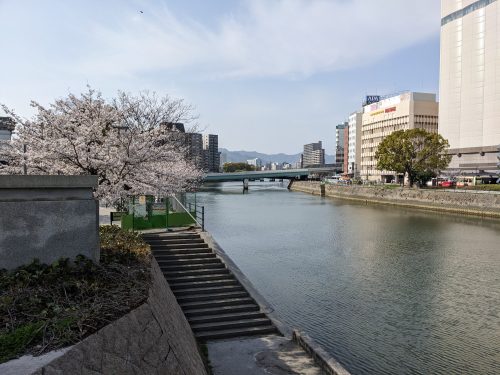
On this episode, I bought myself a “One Day Streetcar Pass” and rode all the streetcar lines, highlighting some of the principal sakura sites on each route. For this article, I will be riding lines #1, #2, #3, #6, #8, and #9. I skipped line #5 because the main cherry blossom attraction (that didn’t overlap with other lines) is Hijiyama Hill and I already covered that, and I also forewent line #7 since its stops overlap with stops on lines #1, #3, and #8, which means no notable sakura sites exist uniquely on line #7. In addition, I am leaving out the big-name sites that are Peace Memorial Park and Miyajima (which can be accessed with the slightly more expensive “One Day Streetcar and Ferry Pass”) because those places deserve their own articles. Finally, even though I could get multiple all-day passes and list every single spot I like along all the streetcar lines, but for the sake of brevity and prioritizing the sites I recommend most, I shall work within the limits of a single day.
Lines #1 & #3: Ujina
Lines #1 & #3 both terminate at Hiroshima Port; the only difference is that the #1 starts at Hiroshima Station and the #3 begins at Nishi-Hiroshima Station. If you’re downtown, you’d board the #1 from Hatchobori or the #3 from the Atomic Bomb Dome and disembark at Kaigandori. I walked south from the streetcar stop until I reached a waterfront promenade, from which I could see the Grand Prince Hotel Hiroshima in the distance, on the other side of the island of Motoujina.

Upon turning left, I proceeded along the promenade, passing by many charming cafés and stores facing Hiroshima Bay, until I reached my first sakura stop. Ujina Hatoba-koen, or Ujina Breakwater Park, is a lesser-known spot for viewing cherry blossoms in the vicinity of Hiroshima Port, and thus, was not congested with tourists. There were only a few cherry trees around the tower, but from a distance, the park itself makes for an imposing sight.

As the cherry blossoms peaked earlier than usual this year, green leaves were already supplanting white flowers by April 1st when I visited. I still managed to get some great shots of the remaining blossoms as well as the hollow-but-majestic tower. Parents and their children were walking, playing, and riding their bikes in the warm sunshine this quiet morning; this is exactly the type of hanami atmosphere I adore.
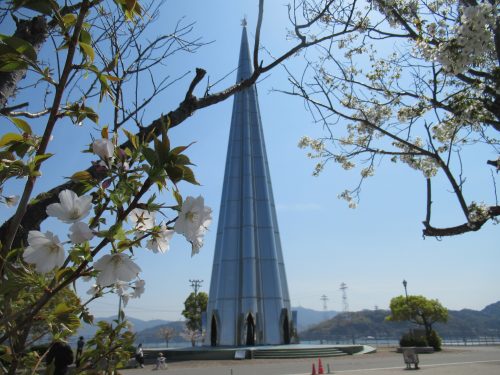
Ujina Breakwater Park is located southeast of Kaigandori Station, but to the southwest of that same station is Hiroshima Minato Park, where last summer’s Bon Dance event was held. Since this park is larger and has more cherry trees, here’s where we start to see more children playing and folks actually picnicking with blankets, tents, the whole shebang. If I had more time, I would’ve also gone out of my way to explore Motoujina, but I could see no sakura from the bridge leading there, so I left it at this site and got back on the streetcar.

Line #2: Miyajimaguchi
Although Miyajimaguchi technically isn’t in Hiroshima City, I’m going to count it since it’s on the same #2 line that starts from Hiroshima Station. As the #2 is an incredibly long line, there are a slew of sakura spots along the way (including everyone’s favorite Peace Memorial Park), but one of the most notable and accessible is the park within the Alpark shopping complex. When traveling by JR, one would disembark at Shin-Inokuchi Station, but when going by streetcar, one alights at Shoko Center Iriguchi (商工センター入口 – Commerce Center Entrance) Station before crossing two streets to the park.
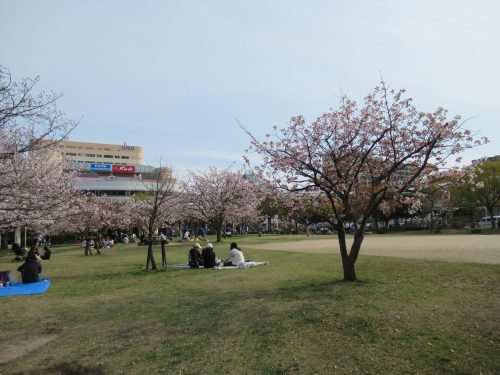
This place may be appealing to those visiting Hiroshima as Alpark is a pretty substantial mall and those with a JR Pass can stop by easily on the way to or from Miyajima. The park pictured above is regularly filled with families and students picnicking and playing sports among the cherry blossoms in April, and if I lived here, I would frequent Alpark more often just for this place. For the moment, however, let us move on to a place international tourists frequent more, the Miyajimaguchi terminus.
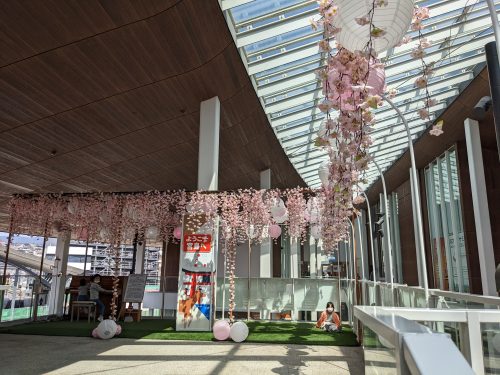
For the real sakura, you’ll want to sail to Miyajima itself, but the facilities around Miyajimaguchi Pier were still adorned with fake sakura and looking convincingly vernal. The atmosphere around here is enjoyable even without cherry trees, and a stop by the shops and restaurants at Miyajimaguchi is strongly recommended before or after sailing to the “shrine island.” I personally would have loved to hop on the ferry, but had a bunch of other sakura sites in Hiroshima to hit up.
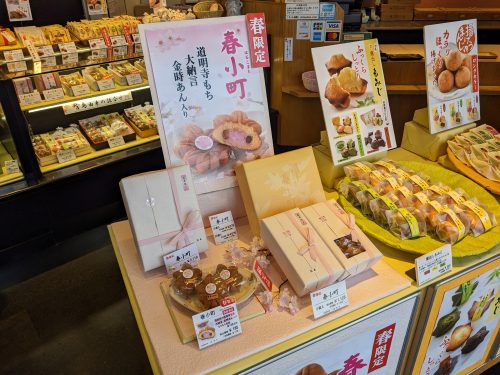
Before leaving, I decided to get myself a souvenir snack food, and when it comes to Miyajima, who could go wrong with any flavor of momiji manju? This one establishment called “Okina-do” was selling a limited-time “Haru Komachi” sporting an interior as pink as the sakura, made with mochi and sweet bean paste. I bought myself two to go, then heard my tummy rumble and decided to stick around for lunch.
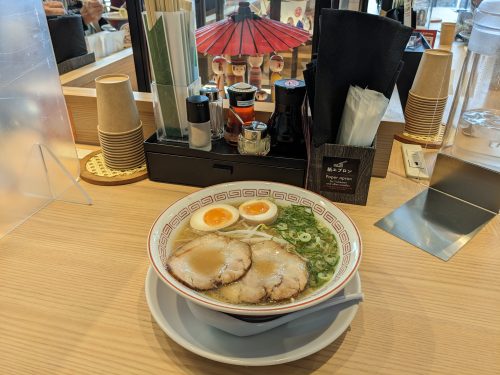
Whenever I have time to spare and am in the Miyajimaguchi area, I always insist on checking out “etto” for their regional souvenirs and restaurant options. The most popular eatery would have to be “Chinchikurin,” an okonomiyaki joint where robots bring the finished products to diners’ tables, but that day, I opted for “Hiroshima Raman Momiji,” which was equally crowded with customers that afternoon. What’s more, there were flyers placed just outside the restaurant with coupons for most of the businesses inside “etto” so I took a flyer, tore off the coupon for the ramen restaurant, and handed it to the server upon placing my order via the ticket vending machine. Thanks to the coupon, I scored a free ajidama (salted boiled egg) with my Hiroshima ramen and dug into my delicious meal at a charming table decorated with traditional kokeshi dolls.
Moment of Joy: Terrace Talent
On a rooftop terrace of a building adjacent to etto, there was a piano that anybody could play for free temporarily situated in the corner. Naturally, lots of kids tended to gravitate towards it to peck at the keys for a bit, which they found amusing. Unfortunately, they were also camera shy, which made me feel bad photographing or filming them, but after taking a walk and returning to the same terrace, I found a woman at the piano playing a rather impressive piece. It was simply pure luck that I came upon such an amazing spectacle, and this performance was the best thing I had ever seen on any trip to Miyajimaguchi without riding the ferry.
Lines #6 & #8: Eba
Next up was the southern terminus of Lines #6 and #8: Eba. Line #6 begins at Hiroshima Station whereas Line #8 starts from Yokogawa Station, so as a tourist, you’re more likely to be getting on the #6. There’s nothing really sakura-worthy during the ride, even when you reach the terminus, but things get good after walking south towards Ebayama Park. When going south, a fork in the road will appear as a tunnel comes into view, but rather than walk straight towards the tunnel, take the narrower road on the right. You’ll pass a supermarket on the way to an T-intersection; turn left and continue until you see a road sloping up like this.
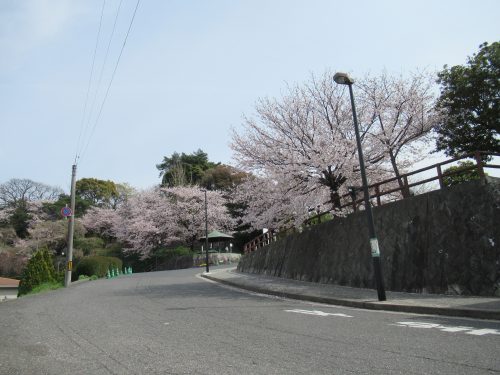
For a place with as many cherry trees as Ebayama Park, you would think that Eba would be touted to more tourists (at least Japanese domestic tourists), but I for one was grateful that it’s not so famous yet. At the top of the incline is an immensely spacious park, with plenty of spots along the main path to play sports or have a picnic under the cherry blossoms. Besides that, Ebayama Park also had some food stalls up, emanating a spring festival vibe; I had to resist the temptation to buy a snack after the noodles I had just eaten.
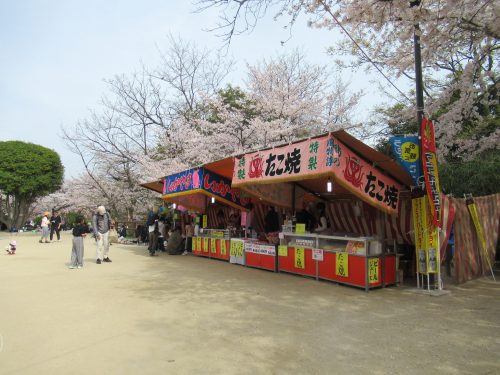
It was my first time seeing the sakura at Ebayama Park, but it wasn’t my first time at Ebayama Park ever. Other than cherry trees, this place also has a meteorology museum nearby, a shrine overlooking Hiroshima Bay, a charming French restaurant, a lookout point where one can see the Marina Hop Ferris wheel, and a secluded area with benches so tired folks can get some rest in solitude. Going back to town was as easy as getting here; if you end up taking the #8 back up, be sure to transfer at Tokaichi unless you want to end up at Yokogawa Station.
Line #9: Hakushima
The final line I want to mention is the #9, which is a mini section of railway jutting out from Hatchobori to Hakushima, so short that the fare is cheaper (at the time of writing, ¥160 as opposed to the usual ¥220 for adults). You probably already guessed the main sakura attraction on this line: Shukkeien, but mainstream as it is, it’s the garden after hours I wish to emphasize. During sakura season, when the sunlight goes out, the lamps inside Shukkeien come on and light up the cherry blossoms.
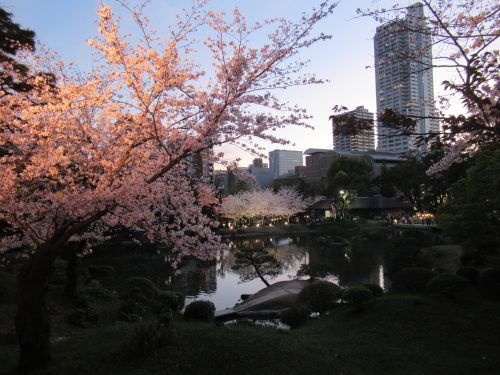
Since not every part of Shukkeien has lamps, only lit areas are open to visitors at night, and paths where it would be too dark and dangerous are blocked off starting at 5:00 p.m. I arrived after that time, but the sun was still in the sky so I walked through the parts of the garden I could until night truly fell. In addition, the picnic plaza right next to the Hiroshima Prefectural Art Museum also had a stall selling snacks, benches for customers to comfortably eat, and a kimono rental service for those who wish to maximize the Japanese-ness of their visit. I was feeling rather peckish at this hour, so I got a piping bowl of oden (savory entrées stewed in broth) and some multi-colored dango (rice flour dumplings on skewers).
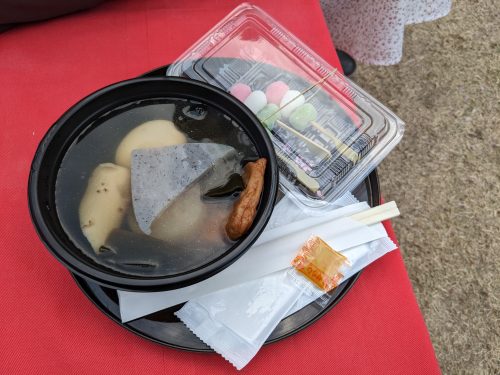
It was a wise idea to show up before the sky got dark, because when day turned to night, the crowds turned up and Shukkeien sold out all their food items. On top of that, to ensure smooth foot traffic, one-way traffic through the garden was enforced. Midway through looking at cherry and peach blossoms, the path takes visitors through the herb garden and through the bamboo forest, which is typically closed to the public and open only during the illumination event.
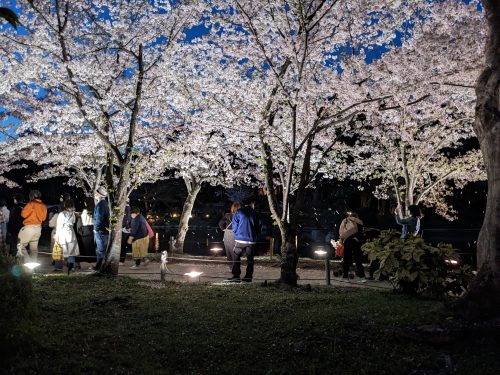
One thing to keep an eye out for in any place with sakura is the hanafubuki (花吹雪 – petal blizzard), when the wind suddenly picks up and carries a ton of loose flower petals to the ground. It happens all the time during peak season, and is a sight to behold each time, but when viewing it at night in the light of all the lamps it was especially dreamy. Not surprisingly, many couples were on dates here for that exact reason, so much so that there was a line of people still waiting to enter even after I was on my way home.

To say that there is an excess of sakura spots in Hiroshima City is no exaggeration, so for those who are indecisive about which ones to swing by, the Hiroden One Day Streetcar Pass may be the perfect purchase. As sakura season is so short anywhere in Japan, I urge visitors to Hiroshima to see as many sakura sites as possible in a day, and if one day isn’t enough, then you might need two of those all-day passes (make one of them include the Matsudai ferry too, so you can hit up Miyajima). In doing so, you will end up knowing more than your typical tourist (and even some Hiroshimarians at that) about the best sites in the city for hanami. Your new, favorite tranquil park in Hiroshima may be just a streetcar ride away!
Written by the Joy in Hiroshima Team
